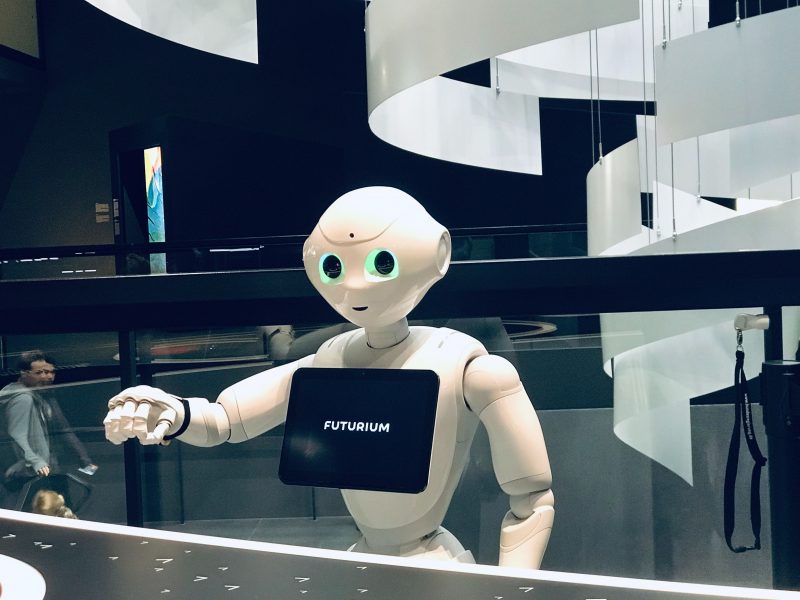Robots in popular culture do not always have a positive image (I-Robot or the Star Wars droids have been very bad ambassadors!).
But we also have those who present themselves as good companions devoted to help humans in their quest.
So on which side should we position ourselves?
Is it the dark side that prevails? What does a robot mean today? The world today is made up of a large number of information systems and software solutions. Some systems that communicate with each other, others completely independent.
The link between all these systems? The human.
It will ensure that information flows smoothly between all systems. It will transfer the data from point A to point B. Does the human therefore just serve as an inter-IS interface? The human is a being endowed with intelligence and this intelligence must be put forward. But how can we highlight it when most of our job is to manage data? Wouldn’t the human need his personal robot to help him in his daily tasks?
Which applications for robotization at work?
What are we talking about when we mention the term robot? We talk about RPA (Robotic Process Automation), or literally: process automation using robots.
They are present to assist the employee in his or her daily work day. Their fields of action can range from a simple unit test on the supervision of an IT infrastructure, to financial reporting, to the management of expense reports or the search for talent to be recruited. As we have seen previously, the RPA’s fields of application are numerous. Wherever people are able to identify and explain the processes they work with on a daily basis, RPA can be used. This makes it ultimately applicable almost anywhere.
What place for the robot in a company?
A robot reproduces human behavior. It can be compared to a trainee who is given tasks to perform, often repetitive and for which the main employee does not use his intelligence and experience of the job.
So in the end, this trainee would only be relayed to carry out missions that his trainee supervisor does not want to do? Not really, the trainee is gifted with intelligence and can learn, he is as likely to make mistakes as any other human being.
But what is the robot-human-trainee relationship? The robot will not learn to be a chartered accountant, it does not have the capacity to learn. On the other hand, he can be asked to write or analyze, and the robot will run without blinking. The robot is therefore an assistant, a valuable daily helper for the employee.
A robot assistant, but why?
We have seen that the robot is an assistant that can help employees on a daily basis. But what exactly is its field of action?
One of the important terms in the RPA is Process. For example, when a support staff member receives a ticket in his or her e-mail box, he or she first opens it, takes the information from the ticket, saves it in a ticketing tool, takes the information from the e-mail and sends a reply to the user telling him or her that the request has been registered. This can seem succinct, easy and not very time-consuming.
What if the server is not operational on a given day and needs to be restarted? On the other hand, tickets accumulate in the mailbox and users get impatient because their tickets are not taken into account. So I will divide my time between saving the tickets and solving my problem with the server.
The time spent justifying to users that their request is well taken into account is wasted time on which the employee could use the intelligence of his job, repair the server. This situation leads to stress, user dissatisfaction and a server down is never good for a budget.
And why not a robot? Why wouldn’t a robot go and look at the emails, take the information and connect to a ticketing tool to fill in the information?
It is true that during this period, with an assistant he could have spent more time on his real problem, worked more serenely and users would have been more satisfied. And this is true in all areas. Every job has its share of time-consuming, repetitive, manual and mandatory tasks. Tasks that are part of the job, but they are based on our true understanding of the job, they put us under pressure, they delay deadlines. Robots and RPA can remedy these problems.
They help employees feel better, more serene in the work environment. They refocus employees on their true knowledge of the job. And if employees are happy in their jobs, the whole company benefits.
The advantages of working with robots
Indeed the robot will never replace an employee. It’s simple, an employee doing only Excel data entry with an accountant diploma will surely change company to use his intelligence of the job elsewhere.
With the RPA, we are able to work with robots. Moreover, this generates new jobs and new skills. RPA business analysts, RPA developers. People dedicated to helping employees and companies be more efficient. People who put intelligence and human value to work for the company. Via robots. Yes, robots are capable of interacting with a large number of systems. Websites, virtual machines, ERPs, business software and so many others.
Robots will interact as a human in these systems, authenticate, navigate, analyze, copy, export, print, etc.. The employee will therefore explain to the RPA developer exactly what he is doing, in which systems and what the robot has to do. Once the robot is in place, he will perform the task with an error rate close to 0%. Who doesn’t know this situation where a report has to be issued quickly involving copying the data from a system, calculating it and putting it in an Excel file.
But working in a hurry, the tests are neglected and the risks of input errors are multiplied.
With a robot, there are no problems with copying, no analysis problems, no time constraints. As a result, while my robot is writing the employee’s daily report, which takes 2 hours, he was able to meet two new customers and make the most of his sales skills.
Restoring the value of human capital
There is no secret, a happy employee is the result of a happy company.
As a Positive Thinking Company consultant, I remember the people I worked with on the RPA. It’s a bit of a wonder, when employees see the robots in operation, beyond the technological advance, it’s the relief I can perceive. “We will save a phenomenal amount of time with these robots“, “we used to spend a lot of time checking our mistakes, now we are more serene“, “with the robot in place, we no longer forget a customer request that falls into a flood of emails“.
Overall, the RPA is a wonderful tool. Everyone and every technological field can be concerned.
Visit our Hyperautomation domain page and Contact us to know how we can support you at the beginning and during the launch of your automation initiative.










